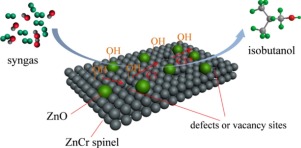Applied Catalysis A: General ( IF 5.5 ) Pub Date : 2017-08-20 , DOI: 10.1016/j.apcata.2017.08.022 Xiaofeng Gao , Yingquan Wu , Guohui Yang , Tao Zhang , Xiaoli Li , Hongjuan Xie , Junxuan Pan , Yisheng Tan

|
A series of ZnO, ZnCr catalysts were prepared by a sol-gel method and ammonia solution was used to adjust the pH of the sol solution. The catalysts were characterized by XRD, in-situ FR-IR, NH3-TPD, in-situ XPS, HRTEM. The results show that lower calcination temperature is helpful to reduce the crystal size and crystallinity of ZnCr nanocrystal, as well as forming a certain amount of structure defects and hydroxyl groups. The hydroxyl groups could be consumed by CO under the interaction between ZnO and ZnCr spinel, resulting in more exposed oxygen vacancies. We find the proper calcination temperature and Zn/Cr molar ratio for the ZnCr catalysts preparation are 400 °C and 1.0, respectively. The Zn1Cr1–400 ∼ 2.0 catalyst prepared with the pH value of 2 shows more hydroxyl groups and small particle size, exhibiting the best catalytic performance both on the CO conversion (20.9%) and isobutanol selectivity (24.2 wt%).
中文翻译:

深入了解羟基在ZnCr催化剂上由合成气合成异丁醇的作用
通过溶胶-凝胶法制备了一系列的ZnO,ZnCr催化剂,并使用氨溶液调节溶胶溶液的pH值。通过XRD,原位FR-IR,NH 3 -TPD,原位XPS,HRTEM对催化剂进行表征。结果表明,较低的煅烧温度有助于减小ZnCr纳米晶的晶体尺寸和结晶度,并形成一定数量的结构缺陷和羟基。在ZnO和ZnCr尖晶石之间的相互作用下,CO可能消耗羟基,从而导致更多的氧空位暴露。我们发现适合制备ZnCr催化剂的煅烧温度和Zn / Cr摩尔比分别为400°C和1.0。Zn 1 Cr 1pH值为2的–400〜2.0催化剂具有更多的羟基和较小的粒径,在CO转化率(20.9%)和异丁醇选择性(24.2 wt%)方面均表现出最佳的催化性能。



























 京公网安备 11010802027423号
京公网安备 11010802027423号